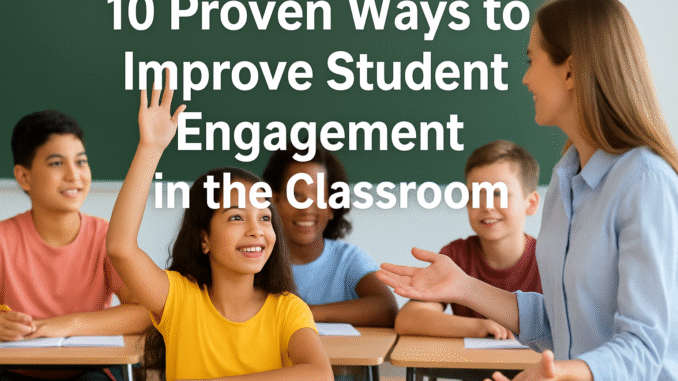
10 Proven Ways to Improve Student Engagement in the Classroom
Student engagement is the heartbeat of effective learning. No matter how well a lesson is planned, it only succeeds when students are actively involved, motivated, and curious. In today’s diverse classrooms, where distractions are many and attention spans are short, finding ways to keep students engaged has become one of the most important goals for teachers.
Engaged students learn better, retain more, and participate willingly. But engagement isn’t just about fun activities — it’s about building meaningful connections between students, content, and the real world.
In this article, we’ll explore 10 proven strategies to improve student engagement in the classroom — all practical, research-backed, and effective for modern educators.
1. Create a Positive and Supportive Classroom Environment
The foundation of engagement is a positive classroom atmosphere. When students feel safe, respected, and valued, they are more willing to participate. Teachers can foster this environment by encouraging open communication, showing empathy, and celebrating small achievements.
Simple gestures such as greeting students at the door, acknowledging their efforts, and listening to their opinions can make a world of difference.
A supportive classroom isn’t just about being friendly — it’s about building trust. When students know their voices matter, they become more confident to share ideas, ask questions, and take academic risks.
2. Make Learning Relevant to Real Life
Students often disengage when they don’t see how lessons connect to their lives. To increase engagement, teachers should link classroom topics to real-world applications.
For example:
- A math teacher might relate percentages to shopping discounts or sports statistics.
- A science teacher could connect lessons about energy to global climate change or electric vehicles.
- A history teacher might discuss how past events influence current global issues.
Relevance sparks curiosity. When students understand why something matters, they become more motivated to learn. Real-world connections help them see education as a bridge to their future goals.
3. Use Interactive Teaching Methods
Traditional lectures can quickly lead to boredom, especially in longer sessions. To improve engagement, teachers should integrate interactive and participatory teaching methods such as:
- Think-Pair-Share: Students think about a question, discuss with a partner, and share with the class.
- Group projects or debates: Encourages teamwork, critical thinking, and communication.
- Hands-on experiments: Perfect for science, art, and technical subjects.
- Role-playing and simulations: Brings lessons to life, especially in history or language learning.
Interactive lessons turn students from passive listeners into active participants, keeping their minds stimulated and focused.
4. Incorporate Technology and Multimedia Tools
In 2025, technology is an inseparable part of education. Students are digital natives who respond well to interactive tools. Incorporating technology can make learning dynamic and exciting.
Some ideas include:
- Using videos, animations, and podcasts to illustrate complex topics.
- Incorporating gamified quizzes through tools like Kahoot! or Quizizz.
- Using virtual or augmented reality to explore new environments.
- Integrating educational apps that allow personalized practice and feedback.
However, technology should complement — not replace — teaching. The key is to use it meaningfully to enhance understanding and participation.
5. Encourage Student Voice and Choice
Giving students a voice in their learning journey increases ownership and motivation. Instead of dictating every activity, teachers can involve students in decision-making.
For example:
- Let them choose between two project topics.
- Allow flexibility in how they present their understanding — essay, video, poster, or digital presentation.
- Invite their feedback on what learning methods work best for them.
When students have choices, they feel empowered and more invested in the outcome. This autonomy nurtures intrinsic motivation, which is the strongest form of engagement.
6. Use Gamification to Make Learning Fun
Gamification — applying game elements to non-game contexts — is a proven way to make learning enjoyable and engaging. By turning lessons into friendly competitions, teachers can spark enthusiasm and teamwork.
Here are some effective ways to gamify the classroom:
- Award points or badges for participation, improvement, or creativity.
- Create leaderboards for quiz results or classroom challenges.
- Use role-playing games or escape-room-style activities for problem-solving.
Gamification transforms the classroom into an interactive adventure, making students eager to learn, compete, and collaborate — all while reinforcing academic content.
7. Promote Collaborative Learning
Students learn best when they learn with and from each other. Collaborative learning fosters communication, cooperation, and social skills — all of which boost engagement.
Group projects, peer teaching, and study circles are powerful methods for encouraging collaboration. Teachers can assign roles (leader, note-taker, presenter, etc.) to ensure participation from everyone.
When students work together, they feel a sense of belonging and accountability. Collaboration also mirrors real-world work environments, helping them build skills that go beyond the classroom.
8. Provide Immediate and Constructive Feedback
Feedback is a crucial motivator in the learning process. When students know how they’re doing — and what they can do to improve — they stay engaged and motivated.
Here’s how to make feedback effective:
- Be timely: Provide feedback soon after an activity or test.
- Be specific: Highlight what the student did well and what can be improved.
- Encourage reflection: Let students assess their own work before receiving your input.
Positive reinforcement helps build confidence, while constructive criticism guides growth. Students who see progress are more likely to stay motivated and involved in their learning journey.
9. Cultivate Emotional and Social Connections
Academic engagement often depends on emotional engagement. Students who feel emotionally connected to their teachers and peers are more enthusiastic about learning.
Teachers can nurture these connections by showing genuine interest in students’ lives — remembering their names, asking about their hobbies, or acknowledging their efforts. Encouraging teamwork, empathy, and respect in class discussions also creates a sense of community.
Social-emotional learning (SEL) programs, mindfulness activities, and reflection exercises can help students manage stress, build resilience, and stay focused.
When emotions are in balance, learning flourishes.
10. Make Learning Active and Movement-Based
Students, especially younger ones, find it hard to sit still for long periods. Active learning methods that involve movement can re-energize the classroom.
Ideas include:
- “Gallery walks” where students move around the room to view others’ work.
- Short movement breaks or stretching activities between lessons.
- Learning games that involve physical activity, such as quiz races or scavenger hunts.
Movement stimulates the brain and boosts focus, creativity, and memory. When students are physically active, they’re more alert and ready to learn.
Bonus Tip: Reflect and Adapt
Finally, great teachers continuously reflect on their practice. Not every strategy will work for every group of students. Regularly ask for feedback — What activities do they enjoy most? What helps them learn better?
Use that input to adjust your methods. Education is constantly evolving, and flexibility is key to maintaining engagement. A teacher who learns alongside their students creates a dynamic, responsive, and inspiring classroom.
The Benefits of Engaged Learning
Engagement isn’t just about keeping students busy — it has real academic and emotional benefits:
- Higher achievement: Engaged students perform better in tests and projects.
- Improved attendance: When students enjoy learning, they show up more consistently.
- Better behavior: Involved learners are less likely to be disruptive.
- Deeper understanding: Active participation encourages critical thinking and creativity.
An engaged classroom is not silent — it buzzes with curiosity, collaboration, and excitement. Students aren’t just memorizing information; they’re experiencing learning.
Conclusion
Improving student engagement is one of the most rewarding challenges in education. It requires creativity, empathy, and a willingness to try new approaches.
From using interactive technology to promoting collaboration and real-world relevance, teachers can transform classrooms into spaces where learning feels alive. The goal is not only to capture attention but also to ignite a lifelong love of learning.
When students are engaged, they don’t just absorb information — they connect with it, question it, and apply it. And that’s what true education is all about.
The classroom of today — and tomorrow — thrives on participation, passion, and purpose. Every small effort a teacher makes to enhance engagement creates ripples that shape confident, curious, and capable learners for the future.

